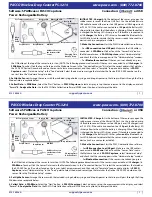
Vega SI-11 / User Manual
5
Revision 25 - 24 June 2021
Hold the start button pressed (min. 5 seconds) to switch the device from the "Active"
mode back to the "Storage" mode.
When switching to the "Storage" mode, all readings from the pulse inputs
accumulated in the device memory are reset
The device forms the data packet with current state with a configurable period from 5
minutes to 24 hours. The packets stored in the device memory and transmitting during the next
communication session with the LoRaWAN
®
network.
The packet is formed at 00.00 on the internal clock of the device if the data collection
period is set to 24 hours, at 00.00 and at 12.00, if the period is 12 hours and so on.
The adjustable data transfer period can be from 5 minutes to 24 hours. Data transferring
in random point in time during set period. At the next communication session, the device starts
sending accumulated packets with readings, from the earliest to the latest.
With the "Confirmed uplinks" option turned on, the device will send the next packet only
after receiving a confirmation of the delivery of the previous one. If such confirmation has not
been received after the fulfilled in the settings uplink number of transmissions, device
completes the communication session until the next one according to the schedule. In this
case, the device continues to collect data according to the data collection period and store it
in memory. Non-transmitted packets remain in the device memory until the next
communication session.
With the "Confirmed uplinks" option turned off, the device just sends all accumulated
packets to the network in order from the earliest to the latest. There are no checks of package
delivery in this mode. After communication session there are no non-transmitted messages in
the device memory.
The internal clock is set automatically when you connect to the device through USB,
also can be adjust via LoRaWAN
®
network.
FUNCTIONAL
Vega SI-11 pulse counter is A class device (LoRaWAN
®
classification) and has the
following features:
ADR support (Adaptive Data Rate)
Sending of confirmed packets
Two operating modes: "Active" and "Storage"
Inputs can be switched to “security” mode for connection to external leakage
and safety sensors, etc.
Queue for sending packets if delivery fails






































